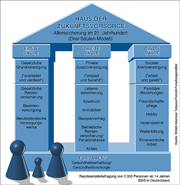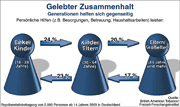Current research, 177
17 December 2003
The intergenerational pact - the social network of the future
The end of the welfare state - a new intergenerational pact?
Securing social systems can no longer just be a question of money. The largely economised demographic and sustainability factor must be expanded to include a social factor. Anyone who is seriously concerned about their own future must understand retirement provision as provision for the future in the sense of material and social security. Only the social safety net - in particular the family - guarantees an equalisation of burdens with sustainability effects that extend far beyond the year 2030, because the generations will remain dependent on each other in the future. This is the result of a new study by the B.A.T Leisure Research Institute, which Federal Minister Renate Schmidt (SPD) presented today in Berlin together with the Scientific Director of the Institute, Prof Dr Horst W. Opaschowski. 2,000 people aged 14 and over were asked about their intergenerational relationships, their personal interaction with each other, their regular contacts and visits as well as their mutual assistance.
The research study shows: The traditional intergenerational contract alone cannot solve the social challenges of the future. „Beyond material security, building a reliable social network is proving to be a stable investment in the future. The loss of family and friends in old age can no longer be compensated for by money,“ says Professor Dr Horst W. Opaschowski, the author of the study „The Intergenerational Pact“, which is now available in bookshops (Primus Verlag).
Provision for the future in the 21st century.
Creating several pillars
A reliable pension scheme is like a stable house of provision for the future, based on the three pillars of poverty prevention, securing the standard of living and ensuring quality of life. No pillar can be replaced by another and is interchangeable. What is meant is a pension scheme based on the three-pillar model with statutory, private and social capital cover that leaves behind sustainable reserves and not just empty coffers. The new house of pension provision stands stably on three pillars: The first pillar is earned and deserved (= basic statutory pension provision), the second pillar is saved and paid for (= supplementary private pension provision) and the third pillar is experienced and lived (= social pension provision). This three-pillar structure on a material and social basis is about more than just money. The narrow economic perspective is contrasted with a balanced generational balance that also has humane and social characteristics. Professor Opaschowski: „The family proves to be the most stable and sustainable form of old-age security. It compensates for a lack of financial capital with social capital - and does so for a lifetime.“
Almost every second German citizen now protects themselves with private life insurance policies (1997: 45% - 2003: 49%). Just under a third of the population rely on the reserves in their own savings account (1997: 29% - 2003: 31%) and on the stable value of property, which has become much more attractive in recent years (1997: 20% - 2003: 29%). Building society savings contracts also remain an important material provision measure (1997: 21% - 2003: 21%) - understandably more so for the younger generation (23%) than for the 50-plus generation (9%). The purchase of shares and securities plays a relatively minor role (1997: 7% - 2003: 11%). Only those with a net household income of over 2,500 euros make more use of investments (21%).
However, social pension provision is categorised as the most extensive and stable provision for the future because it helps to ensure quality of life into old age. This primarily includes maintaining family ties (1997: 51% - 2003: 56%), to which women attach significantly more importance (61%) than men (51%). In recent years, socialising with friends has become much more important (1997: 50% - 2003: 56%). Maintaining a circle of friends is seen as the second most important investment in the future - alongside the family - in the hope that maintaining contacts may even „pay off“ or „pay off“ in old age. A new future opportunity is also emerging for clubs and societies. Around one in six Germans (1997: 16% - 2003: 16%) see joining an association as another way of making personal provisions for the future.
Living cohesion.
Generations help each other
The traditional intergenerational contract was previously understood too one-sidedly as a public transfer payment to the elderly. It did not take into account the services and reciprocal services provided by the generations to each other - from looking after grandchildren to caring for the elderly. Many judgements and prejudices about intergenerational relationships between young and old (e.g. „generational conflict“, „war of the generations“) are no longer tenable:
The cliché „Many old people squander their children's and grandchildren's inheritance“ is something that 94 per cent of the population cannot relate to at all and simply reject. Young and old are largely in agreement here.
The statement: „The old live at the expense of the young“ is also clearly rejected - 94 per cent of Germans believe this to be an unfounded assertion.
„The theory of the elderly as thieves of the future clearly puts the population where it belongs - in the realm of fairy tales and legends,“ says Professor Opaschowski. So far, the population has seen no reason to dramatise the situation. After all, the intergenerational pact on a family basis is working. Young and old attest to each other's high sense of responsibility.
What the younger generation is achieving
If we assume a rough division of the population into the younger (up to 29 years), middle (30 to 64 years) and older generations (65 years and over) and ask about mutual assistance of a material and immaterial nature, we are surprised by the extent and intensity of everyday solidarity practised between the generations. The help starts early and never really stops.
The B.A.T representative survey shows that seven per cent of the younger generation up to the age of 29 regularly support their parents with money. This is supplemented by non-monetary assistance in the form of material goods (8%). And almost a quarter (24%) of those under 29 regularly provide personal help (household chores, errands, care).
What the middle generation achieves
33 per cent of the middle age groups regularly support their children with money, even if they no longer live with their parents. A considerable amount of material resources are also provided (26%). And of course, as a family community of solidarity, they offer additional personal help (23%) with everyday household and family tasks. At the same time, they are available to their parents for personal support (17%). As a so-called „sandwich generation“, the middle generation faces a double challenge - from above (= from the parents) and from below (= from the children).
What the older generation does
Large amounts of money, material resources and personal assistance flow from the older generation to the younger generation. Older people make substantial transfers to their children: money (28%), material resources (20%) and personal assistance (20%). „The nightmare scenarios in which the young simply cancel the intergenerational contract and turn the old into socially homeless people without a place of refuge are completely unfounded,“ says Institute Director Opaschowski. „The old are saving - for the young.“ They do not live at the expense of the young, but make multiple contributions to maintaining the intergenerational contract over the course of their lives. Parents over the age of 65 make seven times as many payments (28%) to their adult children as they receive back from them (4%). On the other hand, the ratio in the area of personal assistance is relatively balanced (older people: 20% - younger people: 17%).
Social pension scheme.
Family and friends as a stable investment for the future
Maintaining family ties has become the most important precautionary measure for old age and almost has the character of a life insurance policy. In addition to the family, the second social investment for the future in old age is maintaining a circle of friends. Friends and family are now valued equally. The systematic maintenance of contacts with family and friends and the ability to keep oneself busy will be the most important mental and social precautionary measures for old age. Opaschowski: „It will therefore be essential to activate the natural potential for help so that friends can be recruited as voluntary helpers. Otherwise, people will remain alone or abandoned.“
Generations with family networks are the primary beneficiaries of the intergenerational pact on a private basis. Everyone else (especially singles and those without children) must ensure that they establish reliable non-related social networks in the course of their lives. People closer and further away must accompany their lives: so-called social convoys outside the family. However, „good friends“ alone are not enough because they are usually the same age and their number decreases with age. Social convoys are only helpful if they are intergenerational. Despite such social innovations, there is actually only one constant in life: the family as a generational pact.
Family policy as a multi-generational policy.
The New Social Task
Policymakers must create a framework in which the burdens on families in terms of time and financial and material resources are not so great that they discourage the younger generation from starting a family. No matter how diverse the lifestyles of the future may be, an effective family policy must be an intergenerational policy that is guided by the principle of the best interests of the child. Failure to do so is irreparable. It is already foreseeable today: In 2040, one in three Germans will have no children and even fewer will have grandchildren. „The generation war is over. Rather, a long phase of intergenerational peace is dawning,“ says Professor Opaschowski. „But on one condition: a future policy for intergenerational relationships that prioritises the quality of life of children, young people, women, families and senior citizens must become the focus of political action.“ In their very personal dealings with each other, the generations rely on the warmth of the family nest and the effectiveness of networks and social convoys such as friends as reliable companions in life. In future, a successful life will mean having a family and/or being socially networked.
The discovery of life together.
The generational conflict is defused
Extending the joint lifetime enables a new solidarity between the generations. Demographic change therefore does not have to jeopardise intergenerational relationships. As long as the middle generation in particular makes its contribution to society through tax and pension payments and at the same time provides education, care and nursing services within the family, the statutory intergenerational contract will continue to exist as a private intergenerational pact without any major conflicts arising. There are many signs that solidarity between the generations is ushering in a new era of responsibility.
Family size will certainly be smaller in the future, but the (multi-) generational family in terms of the simultaneous presence of different generations is becoming increasingly important. There are many indications of increased social solidarity between the generations. The older members of the family are actively intensifying family cohesion: even 80-year-olds today are still keeping their families together and thus ensuring a ritual solidarity that endures. Opaschowski: „There are many indications that today's generation of grandchildren is gaining an importance with increasing age that in some cases goes beyond that of the circle of friends.“
Remain dependent on each other.
The basis of a new generation pact
The research study provides evidence: In addition to the old intergenerational contract, a new intergenerational pact is developing: lived solidarity between the generations. This is an agreement based on family values, a natural exchange of life resources and support services. This intergenerational pact thrives on everyday solidarity, on established social relationships and ties - and not on imposed legal obligations.
The previous scenarios on the social consequences of demographic development „suffered“ from the fact that they only saw people as a cost factor: Growing burdens = financial limits. The exclusively economic approach, in which economic and financial experts set the tone, loses sight of the social dimension, the natural cohesion between people and solidarity between the generations. The intergenerational pact in the form of family cohesion and a sense of community is the basic building block for the future viability of our society.
Focussing on the family does not mean that the material aspects of life have to be overlooked. The Federal Statistical Office shows that the most important source of income for Germans - apart from earned income (40%) - is not a pension (23%), but the family (30%), i.e. relatives, spouses and parents. The family therefore provides a double pension benefit - a capital provision and a social provision. Article 6 of the Basic Law places the family under the special protection of the state, and this is justified by the family's dual pension provision. Insurance companies cannot provide this and circles of friends generally do not want to either. Seen in this light, family support proves to be society's best provision for the future.
It follows from this: The social system may change fundamentally in the future. The family will move back to the centre of life. And the generations will help themselves. While the statutory pension is regressing into a kind of supplementary insurance, the family is taking its place as a reliable full insurance scheme and turning the state intergenerational contract into a private intergenerational pact.
The B.A.T research study „Der Generationenpakt. The social network of the future“ by Horst W. Opaschowski is now available in bookshops (Primus Verlag Darmstadt), ISBN 3-89678-487-0 for € 19.80.
See also directory of all publications





